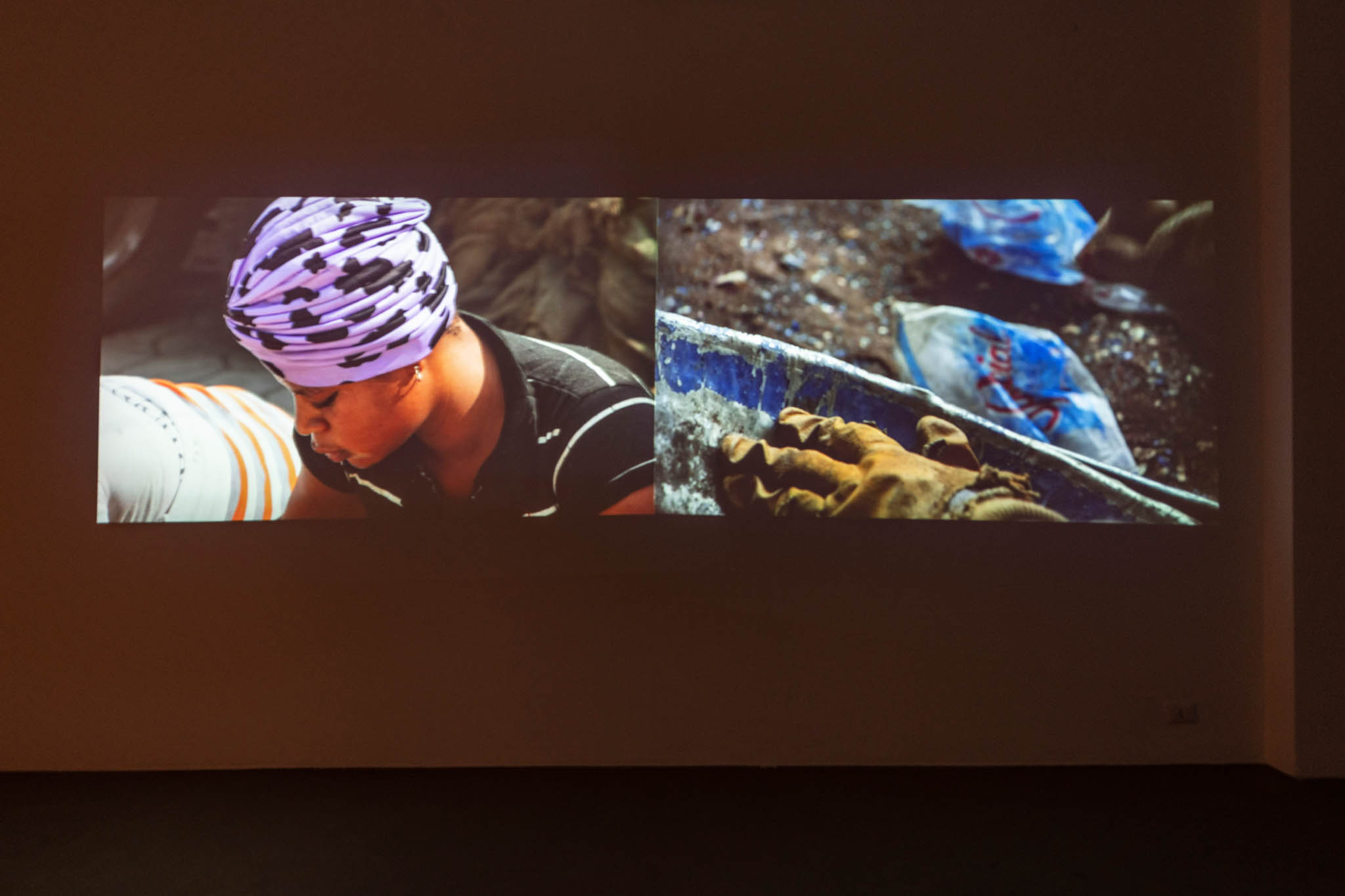Fondazione Giuliani is very pleased to present Living Grains, the first exhibition in Rome of Ghana-based artist, Ibrahim Mahama. The exhibition includes a range of newly commissioned artworks, including a large-scale installation, photographs, drawings and virtual reality film.
Embedded within the specific cultural and socio-political history of Ghana, the work of Ibrahim Mahama addresses issues of globalisation, labour, the exchange of materials and community building, ultimately bringing to the fore a more universal social condition. Mahama is perhaps most well known for his wrapping of architectural structures with jute sacks. Originally made in Southeast Asia and imported to Ghana to transport cocoa beans, these sacks eventually become multi-functional objects reused both by local goods sellers, and for various needs in the home. Both material and commodity trajectory – with its textured skin that retains the imprint of its own history – exemplify the crux of Mahama’s practice: the investigation of the memories and decay of history, cultural fragments, the discarding and future transformation of objects gathered from the urban environment. Through his examination of the history of these objects, Mahama underlies how their evolution over time denotes the developments and changes in contemporary society.\
For the exhibition at Fondazione Giuliani, Mahama worked over a long period of time with a network of “collaborators”, or collecting communities, to gather nearly two hundred disused sewing machines, which he has now transformed into the large-scale installation, Capital Corpses 1 (2014-2019). These machines, so intrinsically associated with the fashion and textile industry, embody a political context in which the industry, and any discussion thereof, completely ignores any taking stock of the decay of objects. The installation also explores sound, an important yet often overlooked component to objects, and acts as a kind of linkage, or echo, of the two films in the exhibition. The two-channel film, Parliament of Ghosts (2014-2019), shows workers in Accra’s Agbogbloshie market, the largest waste site in the world, repetitively remodelling the tin, wood and steel objects left behind by progress. The voiceover to this grim labour comes from 1950s Ghanaian parliamentary debates in which the urgency of unleashing the skills and potential of the nation’s youth is emphasised with an irony that sounds pointedly possible as well as tragic. The virtual reality film, Promises of hanging living men have no dead weight (2014-2019), creates a further echo, as it transports the viewer into the inner workings and machinations of decaying buildings, abandoned silos, and other architectural scenes.
Maps of the Gold Coast (1898-2019) consist of a grouping of defunct maps from the 1920s to 50s. Produced during Ghana’s colonial past, the maps present traces of surveys executed while the English built the country’s railway system (now mostly defunct) to transport goods and minerals, upon which Mahama has drawn minimal interventions. These are accompanied by a series of photographs that depict the inner forearms of women who have travelled from villages close to where Mahama grew up in Northern Ghana to find work as labourers in the capital city of Accra. The women tattoo their arms with their names and the contact details of their next of kin, in case they should be killed or injured in the innumerable road accidents or on building sites. This crisis, Mahama believes, is an opening to starting a new conversation regarding the condition of the body in the 21st century and beyond.
Ibrahim Mahama was born in 1987 in Tamale, Ghana; he lives and works in Accra, Kumasi and Tamale. A selection of his most recent international solo shows include: Parliament of Ghosts, The Whitworth, University of Manchester, UK (2019); Labour of Many, Norval Foundation, Cape Town, South Africa (2019); A Friend, Fondazione Nicola Trussardi, Porta Venezia, Milan (2019); A straight line through the Carcass of History, 1918-1945, daadgalerie, Berlin (2018); In Dependence, Apalazzo Gallery, Brescia, Italy (2018); On Monumental Silences, Extra City Kunsthal, Antwerp (2018); In the White Cube: Fragments, White Cube, London (2017); Fracture, Tel Aviv Museum of Art (2016). He has participated in numerous prestigious group exhibitions, including No Time for Caution 1966, La Biennale de l’Art africain contemporain: DAK’ART, Dakar, Senegal (2018); Documenta 14, Kassel, Germany and Athens (2017); All the World’s Futures, 56th Venice Biennale (2015). This year he co-represented Ghana in Ghana’s first national pavilion at the 58th Venice Biennale.
In March 2019, Mahama founded an artist-run exhibition space, research site and artists’ residency, The Savannah Centre for Contemporary Art (SCCA), in Tamale, Ghana. As an extension of his artistic practice, the intention of the artist is to invest in one’s community while forwarding the development and expansion of the contemporary art scene in Ghana.
























